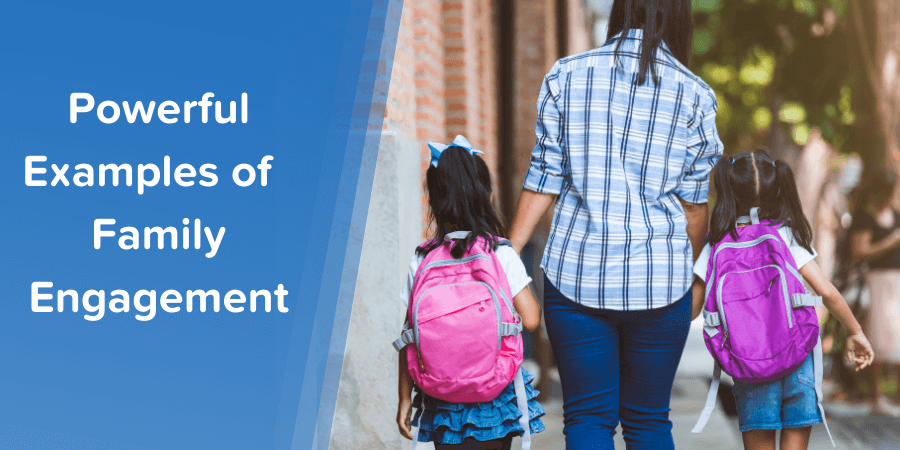by Maren Madalyn, contributing writer
Let’s be honest: the pandemic has radically impacted each and every one of us in education. In some ways, educators learned valuable insights about how district and school leaders can shift teaching and learning to better support students as well as teachers. And, in other cases, schools are still determining what their “right path forward” for student success might look like.
The challenge of reversing the negative trends in children’s education from the pandemic can feel daunting for many educators. This is why schools need strong family partnerships. If anything can help a school community heal – and build a positive, resilient school climate – it will be trusting relationships with these critical stakeholders in a child’s life.
In fact, many educators already recognize the importance of family involvement in education. Its known benefits and positive impact on children’s education are just the tip of the iceberg when it comes to the potential offered by a strong family-school partnership. They include boosts to student achievement, both child and adult well being, better attendance rates, and much more. It’s well worth the time and effort spent encouraging parents, caregivers, and guardians to help schools build a supportive learning environment for students
The question then becomes this: what does strong family and community engagement in schools look like? And can educators glean takeaways for their community by studying examples of family engagement in schools (and how they intersect with examples of equity in education)?

Stronger family relationships bolster student learning
We at ParentPowered work with hundreds of organizations and schools seeking to tap into that potential and build strong relationships with the families they serve. Every so often, we receive that very question from our partners about best practices for involving families in their child’s school, or some variation of it.
“What are you seeing other organizations doing when it comes to family engagement and school improvement? Do you see schools trying this strategy? What impact does their approach have on things like school climate, student learning experiences, etc? What’s NOT working for other districts?”
Organizations are eager for inspiration from fellow educators, and we are in a unique position to help.
By partnering with district, school, and community partners across the US, we gain valuable insight into a wide range of family engagement strategies. We also learn how teachers, school administrators, district leaders, and community leaders bring these efforts to life to cultivate strong connections beyond onsite school events like Open Houses or parent-teacher conferences.

The reality is that there is no one-size-fits-all approach to increase family involvement and collaboration with school. Examples of family engagement in schools can look completely different between districts or community organizations – even if they are in the same state, serve the same age groups, or work with similar populations. The best approach to family engagement is the one that works for school leaders, school staff, and the families they serve.
Here’s the good news: the most effective examples of family engagement in schools share several common factors that educators can adapt to meet their community’s needs.
By understanding the core elements of impactful family and community engagement examples, school teams can evaluate their own school programs and create engagement opportunities that work for everyone supporting a child’s education.
Have questions about family engagement in schools?
Explore our FAQs at the end of the article.
Key Takeaway: The best examples of family engagement in schools offer immense benefits to schools and students. Engaged families in partnership with their school staff play active roles in crafting strategies that support student learning. Common factors can guide family engagement programs to ensure families of all backgrounds and cultures have opportunity to contribute meaningfully to student outcomes.
Exploring examples of family engagement in schools
Because caregiver and parent engagement is important to student success, let’s take a look at three examples of effective family involvement from the field! Each example offers valuable lessons for educators to study as inspiration for their own ideas to build relationships among their school community members.
In each story, we also highlight how each approach leverages the essential conditions from the Dual Capacity-Building Framework and its impact on family members and students. To learn more about this model for family-school partnerships, take a look at our FAQs below.
Example #1: Connecting Families with Essential Resources
Our first example comes from Del Norte County, a rural community in northern California near the Oregon border. Like many rural areas throughout the United States, Del Norte faced challenges with providing equitable access to high quality education and local health resources to its community members.
As part of an initiative to improve family engagement in early childhood education, Del Norte County worked closely with their community of families, educators, and childcare providers to understand their biggest needs. Through a series of informal gatherings, their team collected feedback.

The trend was resoundingly clear – Del Norte had a big opportunity to help connect families with crucial resources and services around them. Bolstering family involvement and access within their community could also impact outcomes like student achievement, learning experiences, and much more if families’ basic needs were better met.
However, the team needed to go beyond providing in-person activities for families, which some were not always able to join. They also needed to provide resources without requiring access to the internet, something some families struggled with in their area.
This realization sparked a collaboration between ParentPowered and Del Norte County to develop a customized community outreach program to connect families with local resources and service providers. Hundreds of services, ranging from educational parenting guides to student mental health resources to homework help, were highlighted in weekly outreach to families, with text messages personalized to their unique community context.
The timing was fortuitous, as this program was already in full force when the COVID-19 pandemic forced schools to close their doors in 2020. Through collaborations with the local school organizations, Del Norte County ensured that the program could provide families with just-in-time information and support even during such challenging times.
Del Norte County’s powerful approach to family and community engagement incorporated multiple aspects of Dr. Mapp’s essential conditions. But two details in particular stand out.
First, by utilizing a text-based program, the team ensured that families received support without needing access to the internet or being physically present at a particular location. This created equitable opportunities for families to actively cultivate learning moments at home with their children – and such family engagement activities at home can directly benefit student work.

Second, Del Norte County’s messages connected families with specific, concrete resources that could meet their most essential needs. When a family’s basic needs are met, it can increase family involvement in their children’s education.
Learn more about the inspiring story behind Del Norte County’s family engagement program here.

Example #2: Equitable Opportunity through Digital Family Engagement
Our second example comes from West Contra Costa Unified School District (WCCUSD), also located in California but amidst the hustle and bustle of a city. WCCUSD served a huge array of diverse families, not only culturally and linguistically but also social-economically. The needs of these families could not be more different in some cases.
As a result, district and school leaders faced this question: how do we help families get actively involved as partners in their child’s learning experience, regardless of income level or cultural background?
Their answer: build relationships between school and home through digital family engagement.
Partnering with ParentPowered, WCCUSD implemented a text-based program inviting parents and other family members to receive text messages weekly delivered straight to their phones. Each message included educational resources for families in the form of fun, easy at-home learning activities appropriate to their children’s grade levels or age groups. Each tip only took parents minutes to do and fit well into existing daily routines in a family’s life.
This positive communication with families also helped the district build relationships with families by supplementing parent expertise with valuable insight and activities to support students both at school and at home. Taking this strengths-based approach helped build trust and respect between WCCUSD and their families – critical components to any successful partnership.
The benefits of this strategy continued to shine for WCCUSD families and educators when it came to social-emotional learning (SEL) and well being. Parents involved in the program received messages that encouraged exercises to practice SEL skills with kids and even shared methods to cultivate parental self-care – both of which can strengthen the family-child relationship, too. In fact, when recently surveyed, 100% of this district’s families shared that their relationships with their children grew stronger after completing their ParentPowered activities.
Digital family engagement continues to be a game changer for WCCUSD to cultivate parent engagement and build powerful partnerships with their diverse families. Learn more about the impact of this digital method for involving parents in students’ education here.

Example #3: Improving Literacy through Family Engagement Activities at Home
Our third and final example takes us to a community partner on the other side of the US – in Raleigh, North Carolina. Wake Up and Read, an early learning organization serving families of young learners, was on a mission to ensure that “every [one of our] children… will be inspired, equipped, and empowered to read.” While the organization offered many fun activities for families and students to build literacy (practicing things like decoding skills in reading), their team knew that not all families could join these events, often held in-person. This partner needed a way to bring engagement their families – to meet them where they are.
Through partnership with ParentPowered, Wake Up and Read launched a text-based family engagement program focused on literacy. Parents selected their preferred language for receiving these messages, ensuring that any valuable resource shared was easily understood and accessible. Further, by delivering fun activities to spark literacy moments at home via text, families gained useful insights “right in their own pocket” – no extra travel, babysitting, or days taken off work necessary.
These activities were easy for families to slip right into their normal schedules with students. The ease of use meant that barriers such as lack of time did not hinder family involvement in student learning. Parents, caregivers, and guardians working with Wake Up and Read shared in a recent survey that they “appreciated how simple [the activity] is” and that they find the messages “easy or very easy to understand”.
Learn more about how Wake Up and Read used ParentPowered to improve literacy at home with families here.
Family engagement: partnership for long-term success
Beneath these and other examples of family engagement in schools lies the theme of establishing partnership between home and school. A truly reciprocal partnership takes time, consistency, and energy to nurture with families – there is no “hack” to parental engagement.
But though no shortcut exists – strong family partnerships are absolutely worth it. By cultivating trust and collaboration with their parents and other community members, schools build the best team possible to enable a school and student’s success – the goal of every effort to involve families!

FAQs about Family Engagement
Take a look at these frequently asked questions to learn more about the essentials of family engagement in schools.
What is family engagement?
The National Association for Family, School, and Community Engagement (NAFSCE) defines family engagement as follows:
Family engagement is “a shared responsibility in which schools and other community agencies and organizations are committed to reaching out to engage families in meaningful ways and in which families are committed to actively supporting their children’s learning and development.”
Regardless of the types of families an organization supports, family engagement efforts are most effective when they establish trust between home and school. Strong connections built through trust help both parties to then effectively communicate and collaborate with one another to support a child’s experience with learning.
Family involvement vs. engagement – what’s the difference?
“Family involvement” is another term often cited in education as a strategy for improving student learning. As the Annie Casey Foundation describes, “An involved parent takes part in the activities already determined by the school. An engaged parent takes a step further, often becoming part of the school’s decision-making process.”
Following this definition, parent involvement centers on participation in school events driven by the school. It may look like attending parent-teacher conferences, joining a family workshop in the school setting, and even volunteering in the classroom or at other school activities. Each of these examples might be organized solely by the school. On the other hand, parent engagement strategies would emphasize schools creating the opportunity for parents to actively add their voice to planning, develop their own skills, and even take ownership over ideas for improving student learning.
This next-level collaboration might involve more meaningful, two-way communication between school and home. Or it could focus on incorporating direct family feedback into a school’s vision of family engagement. Take a look at our guide to crafting communications with families for more information.
The difference here is that, unlike parental involvement, parent engagement establishes collaboration between school staff and families centered on student learning. It’s about building a partnership and cultivating relationships with families supporting a student. And this builds an entire learning team dedicated to that student’s well-being.

What are the primary benefits of family engagement?
Family-school partnerships positively impact schools, families, and students. Studies show that when families are actively engaged with their children and involved in their child’s education, students tend to perform better academically and socially.
Examples of improved student outcomes include:
- Improved graduation rates
- Boosted math and reading scores
- Increased teacher satisfaction
- Higher levels of motivation and persistence in student work

Ultimately, family engagement is about building partnerships between home and school, supporting a student to continue their learning across both environments and beyond. Effective examples of family engagement in schools ensure that parents, caregivers, and guardians have the resources and support needed to foster participation in student learning.
Click here to learn more about the power of family engagement on student achievement and other school outcomes.
How do schools build family engagement?
What families need from schools and organizations to support student learning varies between communities. As a result, there is no one-size-fits-all approach to building strong partnerships with families of different backgrounds and needs. What’s most important is that school administrators take time to understand their school community and adapt family engagement events and resources to meet their needs.
At the same time, some of the most effective family engagement practices lean on core principles that tap into the potential offered by families. Examples of these principles include inviting parents and other family members into two-way communication flows, incorporating family input into the school decision-making processes, and offering accessible, culturally-responsive ways for parents to support their child’s education. These principles create a culture of collaboration and communication with families, schools, and students.
Learn more about these principles and how they impact family engagement programs.
At the same time, some of the most effective family engagement practices lean on several core principles that tap into the potential offered by families. Examples of these principles include creating two-way communication flows and incorporating family input into decision-making processes. These principles create a culture of collaboration and communication with families, schools, and students. Click here for more information about these principles and how they impact family engagement programs.

About the author
Maren Madalyn has worked at the intersection of K12 education and technology for over a decade, serving in roles ranging from counseling to customer success to product management. She blends this expertise with fluid writing and strategic problem-solving to help education organizations create thoughtful long-form content that empowers educators.






